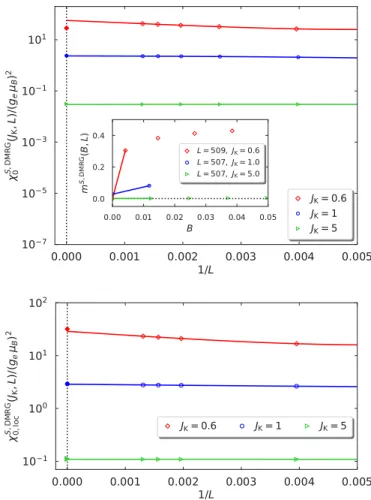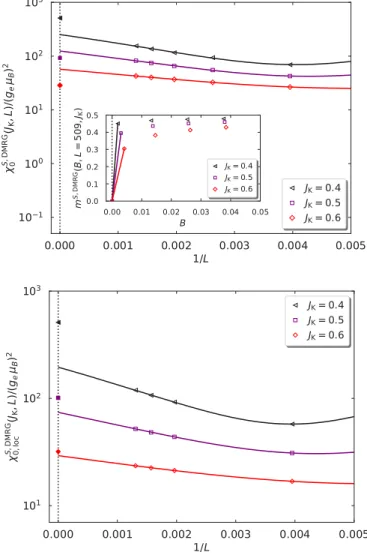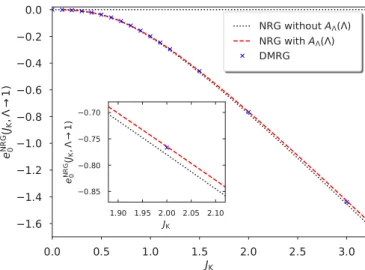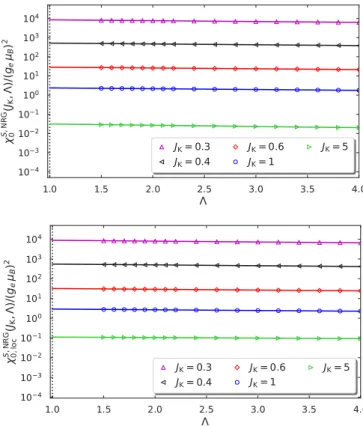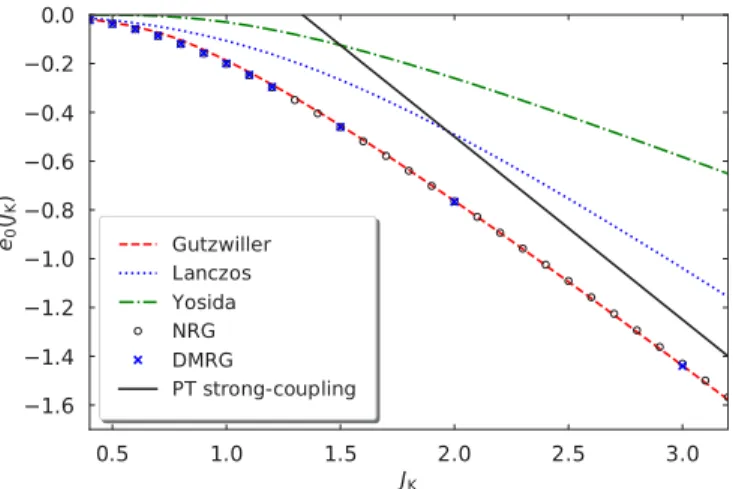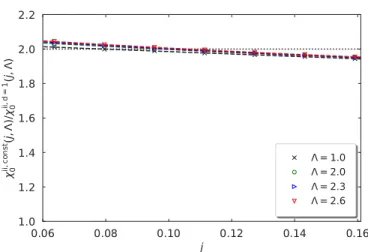Editors’ Suggestion
Symmetric single-impurity Kondo model on a tight-binding chain:
Comparison of analytical and numerical ground-state approaches
Gergely Barcza,1Kevin Bauerbach ,2Fabian Eickhoff,3Frithjof B. Anders ,3Florian Gebhard ,2,*and Örs Legeza1
1Strongly Correlated Systems Lendület Research Group, Institute for Solid State Physics and Optics, MTA Wigner Research Centre for Physics, P.O. Box 49, H-1525 Budapest, Hungary
2Fachbereich Physik, Philipps-Universität Marburg, D-35032 Marburg, Germany
3Theoretische Physik 2, Technische Universität Dortmund, D-44221 Dortmund, Germany
(Received 19 November 2019; revised manuscript received 27 January 2020; accepted 27 January 2020;
published 24 February 2020)
We analyze the ground-state energy, local spin correlation, impurity spin polarization, impurity-induced magnetization, and corresponding zero-field susceptibilities of the symmetric single-impurity Kondo model on a tight-binding chain with bandwidth W =2D where a spin-12 impurity at the chain center interacts with coupling strength JK with the local spin of the bath electrons. We compare perturbative results and variational upper bounds from Yosida, Gutzwiller, and first-order Lanczos wave functions to the numerically exact extrapolations obtained from the density-matrix renormalization group (DMRG) method and from the numerical renormalization group (NRG) method performed with respect to the inverse system size and Wilson parameter, respectively. In contrast to the Lanczos and Yosida wave functions, the Gutzwiller variational approach becomes exact in the strong-coupling limitJKW, and reproduces the ground-state properties from DMRG and NRG for large couplingsJKW, with a high accuracy. For weak coupling, the Gutzwiller wave function describes a symmetry-broken state with an oriented local moment, in contrast to the exact solution.
We calculate the impurity spin polarization and its susceptibility in the presence of magnetic fields that are applied globally or only locally to the impurity spin. The Yosida wave function provides qualitatively correct results in the weak-coupling limit. In DMRG, chains with about 103 sites are large enough to describe the susceptibilities down to JK/D≈0.6. For smaller Kondo couplings, only the NRG provides reliable results for a general host-electron density of states ρ0(). To compare with results from Bethe ansatz that become exact in the wide-band limit, we study the impurity-induced magnetization and zero-field susceptibility. For small Kondo couplings, the zero-field susceptibilities at zero temperature approach χ0(JKD)/(gμB)2≈ exp[1/(ρ0(0)JK)]/[2CD√
πeρ0(0)JK], where ln(C) is the regularized first inverse moment of the density of states. Using NRG, we determine the universal subleading corrections up to second order inρ0(0)JK.
DOI:10.1103/PhysRevB.101.075132
I. INTRODUCTION A. Kondo problem and Kondo model
Magnetic moments that couple antiferromagnetically to electron spins of a metallic host pose a difficult many-particle problem because the spin-flip scattering of the host electrons off the impurity spin couples the bath degrees of freedom in an intricate way. Experimentally, this leads to surprising phenomena such as the Kondo resistance minimum around some characteristic low-temperature energy scaleTK[1], often referred to as the Kondo temperature.
Using standard high-temperature perturbation theory to third order in the coupling between the impurity spin and the host electrons, Kondo was able to explain the resistance minimum [2]. However, within standard perturbation theory the resistivity and many other physical quantities like the zero-field magnetic susceptibility diverge logarithmically at
*florian.gebhard@physik.uni-marburg.de
zero temperature. A summation of the leading logarithmi- cally diverging terms in the perturbation expansion leads to a divergence at TK [3,4]. Consequently, approaches beyond perturbation theory are required to describe adequately the ground state of the coupled system of impurity spin and host electrons [4].
This “Kondo problem” inspired the development of scal- ing concepts that were eventually formalized in Wilson’s renormalization group (RG) [5]. Since the Wilson RG can be carried out analytically only to a limited degree, it found its widespread implementation as numerical renormalization group (NRG) method which is best suited for the study of impurity problems [5–7]; for a review, see Ref. [8].
At zero temperature, the impurity spin and the electrons in its surrounding “Kondo cloud” form a “Kondo singlet”
as the many-particle ground state; its elementary excitations describe a Fermi liquid [9]. The Bethe ansatz permits the exact solution of the Kondo model with infinite bandwidth (see the reviews by Tsvelick and Wiegmann [10] and by Andrei, Furuya, and Lowenstein [11]). The Bethe ansatz confirms the findings of (N)RG, and provides analytical formulas, e.g.,
for the impurity magnetization at finite temperatures, and for the Kondo temperature in terms of the Bethe-ansatz parame- ters. Since NRG provides explicit results also for dynamical quantities at finite temperatures, the Kondo problem could be declared “solved.”
The Kondo problem poses one of the fundamental chal- lenges in theoretical many-body physics. Therefore, one might think that the ground-state properties of the Kondo model have been studied in very much detail. Surprisingly, this is not the case. For example, the dependence of the ground-state energy on the Kondo coupling is largely un- known, apart from a study by Mancini and Mattis who used the Lanczos approach [12]. To the best of our knowledge, the large-coupling limit of the Kondo model has not been ana- lyzed extensively yet. Moreover, more elaborate variational states such as the Gutzwiller wave function were not applied to the Kondo model thus far.
It was not until recently that Schnack and Höck used the NRG to investigate the magnetization and zero-field suscepti- bility for some weak couplings [13]. They emphasized that the impurity spin polarization differs from the impurity-induced magnetization for the whole system, as derivable from the free energy. Moreover, they revived the question how the Bethe-ansatz results can be used for comparison with NRG data because the Kondo couplings in the Bethe ansatz and for a lattice model are related in a nontrivial way. For the series expansion of the Bethe-ansatz couplingJKBA in terms of the bare model parameter JK, only the leading-order terms are known analytically from scaling arguments [4] and Wilson’s RG [5].
With our work, we fill some of the gaps in the quantitative analysis of the symmetric Kondo model at zero temperature.
We study the ground-state energy, the local spin correlation function, the impurity spin polarization and the impurity- induced magnetization as a function of a global and a local magnetic field, and the corresponding zero-field susceptibil- ities. In the absence of an external field, we perform weak- coupling and strong-coupling perturbation theory. We employ three analytical variational approaches (first-order Lanczos [12,14,15], Yosida [16,17], and Gutzwiller states [18,19]), and perform numerical calculations using the density-matrix renormalization group (DMRG) [20–22] and the numerical renormalization group methods [5–8,13]. We compare to Bethe-ansatz [10,11] results where possible.
B. Outline
Our work is organized as follows. In Sec.IIwe define the Kondo Hamiltonian on a chain and the ground-state properties that we investigate in the thermodynamic limit, namely, the ground-state energy, local spin correlation function, impurity spin polarization and impurity-induced magnetization, and the corresponding zero-field magnetic susceptibilities.
In Sec.IIIwe employ perturbation theory as first analytical method to derive the ground-state energy and the local spin correlation for weak and strong Kondo couplings. These results provide a benchmark test for all approximate analytical and numerical methods.
Next, in Sec. IV, we derive a variational bound for the ground-state energy from the first-order Lanczos state. As the
energy bound is poor, we refrain from calculating magnetic properties for this state.
As a more suitable variational state, we study the Yosida wave function in Sec.V. When properly generalized to finite magnetic fields, it permits the analytic calculation of magnetic ground-state properties in the presence of a local and a global magnetic field. Although the Yosida state gives a poor esti- mate for the ground-state energy, it provides a qualitatively correct description of the zero-field magnetic susceptibilities at small Kondo couplings.
As a third analytic variational approach, we study the Gutzwiller wave function in Sec. VI. It can be viewed as a Hartree-Fock ground state for the Kondo model where the condition of a spin on the impurity is guaranteed. From the Hartree-Fock perspective, it is not too surprising that the Gutzwiller state contains an artificial transition from a phase with a broken local symmetry at small Kondo couplings to a phase with a local spin singlet at large Kondo couplings. Apart from this flaw, the ground-state energy and the local spin correlation are in very good agreement with numerically exact data from NRG and DMRG. The Gutzwiller state becomes exact for strong couplings.
As the last analytic approach, we recall results from the Bethe ansatz in Sec. VII. The Bethe ansatz solves a related Kondo model that has a linear dispersion relation with an infi- nite bandwidth so that it is a nontrivial task to establish the link to the parameters in the lattice model. This is accomplished by Wilson’s renormalization group, and we use perturbation theory to calculate analytically the leading-order terms for the zero-field impurity-induced susceptibility.
In Sec.VIIIwe discuss two numerically exact approaches to the Kondo problem, namely, the numerical renormalization group (NRG) and the density-matrix renormalization group (DMRG) methods. The DMRG treats finite chains with up to L≈1000 sites with a very high numerical accuracy. Thereby, DMRG provides excellent variational upper bounds for the ground-state energy and the local spin correlation function.
Since it has an essentially constant energy resolution over the whole band, our present version of DMRG cannot access the exponentially small Kondo scale that develops for small Kondo couplings. The NRG was developed and designed to treat these Kondo scales and therefore provides access to small Kondo couplings as well.
In Sec. IX we compare the results of all methods. The Gutzwiller approach provides the best analytic variational state for the ground-state energy and the local spin correlation function. The Gutzwiller wave function becomes the exact ground state for large Kondo couplings, and reliably describes the physics when the Kondo coupling becomes larger than the host-electron bandwidth. The DMRG provides excellent values for the ground-state properties, and our analysis of the finite-size data only fails to describe magnetic proper- ties when the Kondo energy scale becomes exponentially small. The NRG is found to work very well for all cases.
In particular, it permits to determine the different sublead- ing terms of the zero-field magnetic susceptibilities when they become exponentially large as a function of the Kondo coupling.
In Sec. X, we summarize and briefly discuss our find- ings. We defer technical details to Appendix Aand provide
extensive calculations in the Supplemental Material [23], as listed in AppendixB.
II. SINGLE-IMPURITY KONDO MODEL ON A CHAIN We start our investigation with the definition of the model Hamiltonian. Next, we list the ground-state quantities that we study in this work.
A. Hamiltonian of the single-impurity Kondo model In the strong-coupling limit, a Schrieffer-Wolff transfor- mation maps the symmetric single-impurity Anderson model (SIAM) to the the s-d (or single-impurity Kondo) model (SIKM) [4,24,25]
HˆK=Tˆ +Vˆsd+Hˆm. (1) We consider a chain with an odd number of sites L, n=
−(L−1)/2, . . . ,(L−1)/2, and we chooseLsuch that (L+ 3)/2 is even. The operator for the kinetic energy of the conduction electrons reads as
Tˆ = −t
(L−3)/2 n=−(L−1)/2,σ
( ˆc+n,σcˆn+1,σ+cˆ+n+1,σcˆn,σ). (2) In the absence of an external magnetic field, we address a paramagnetic half-filled systemN↑ =N↓=(L+1)/2.
The impurity couples purely locally at the center of the chain. For a local hybridization in the symmetric SIAM and for strong coupling, the Kondo coupling becomes
Vˆsd =JKs0·S,
s0·S= 12( ˆc+0,↑cˆ0,↓dˆ↓+dˆ↑+cˆ+0,↓cˆ0,↑dˆ↑+dˆ↓)
+14( ˆd↑+dˆ↑−dˆ↓+dˆ↓)( ˆc+0,↑cˆ0,↑−cˆ0,↓+ cˆ0,↓). (3) The host electron spins0 at siten=0 interacts locally with the impurity spinSwith coupling strengthJK0. Note that in Eq. (3) it is implicitly understood that ˆHKonly acts in the subspace of singly occupiedd levels.
To study the magnetization and magnetic susceptibility, we add an external magnetic fieldH>0,
Hˆm= −B
dˆ↑+dˆ↑−dˆ↓+dˆ↓+
(L−1)/2 n=−(L−1)/2
ˆ
c+n,↑cˆn,↑−cˆ+n,↓cˆn,↓
, (4) where we denote the magnetic energy by
B=geμBH/2>0, (5) ge≈2 is the electronic gyromagnetic factor, and μB is the Bohr magneton. For completeness, we shall also consider the case where the magnetic field is applied only at the impurity site
Hˆm, loc= −B( ˆd↑+dˆ↑−dˆ↓+dˆ↓). (6) The kinetic energy of the host electrons is diagonal in momentum space (see AppendixA 1)
Tˆ = L k=1,σ
kaˆ+k,σaˆk,σ (7)
with the dispersion relationk. The corresponding density of states is defined by
ρ0(ω)= 1 L
L k=1
δ(ω−k)= 1 π
1
(2t)2−ω2 (8) for|ω|<2t. We use half the bandwidth as our unit of energy, 2t ≡1,W ≡2, to make a direct contact with the Bethe-ansatz calculations. In numerical DMRG calculations, the model is mapped onto a half-chain with the impurity at the left chain end. This is done in AppendixA 2.
For some of our analytic calculations, we shall treatρ0(ω) as a selectable quantity. In all cases, the density of states is supposed to be regular at the Fermi energy 0< ρ0(0)<
∞. This rules out, e.g., a tight-binding model for the host electrons in two dimensions with its logarithmic van Hove singularity at the Fermi energy. Note that, for JK→0, it is mostlyρ0(0) that governs the physics of the SIKM. Therefore, the results for a one-dimensional or a constant density of states are representative for the symmetric SIKM at weak coupling.
B. Ground-state properties
In this work, we are interested in the excess ground-state energy due to the presence of the coupled impurity spin, the local spin correlation the impurity spin polarization for a global and a local field, and the corresponding susceptibilities.
Moreover, for comparison with Bethe ansatz, we also address the impurity-induced magnetization and zero-field suscepti- bility for global and local fields.
1. Ground-state energy and local spin correlation We calculate the excess ground-state energy due to the presence of the impurity, i.e., the impurity-induced change of the ground-state energy of free electrons,
e0(JK,L)=E0(JK,L)−EFS(L). (9) The impurity-induced energy contributione0(JK,L) is of or- der unity ande0(JK=0,L)=0. Eventually, we extrapolate to the thermodynamic limit
e0(JK)= lim
L→∞e0(JK,L). (10)
This is done explicitly using DMRG. In contrast, the NRG dis- cretizes the continuum model in energy space (see Sec.VIII).
The analytic calculations are directly performed in the ther- modynamic limit.
Another quantity of interest is the local spin correlation function in the ground state
C0S(JK)= s0·S. (11) It can either be calculated directly, or from the Hellmann- Feynman theorem (see AppendixB 1) [26,27]:
C0S(JK)= ∂e0(JK)
∂JK
. (12)
In turn, we may calculate the ground-state energy from the local spin correlation using
e0(JK)= JK
0
dJ C0S(J). (13)
Therefore, Eq. (13) can be used to check the consistency of the ground-state calculations because Eqs. (12) and (13) hold for the exact ground state. Note that the Hellmann- Feynman theorem also applies to variational approaches (see AppendixB 1).
2. Ground-state impurity spin polarization, impurity-induced magnetization, and zero-field susceptibilities
a. Global external field. In the presence of an external magnetic field H, the spin on the impurity orients itself so that the spin projection into the direction of the external field becomes finite. We denote the impurity spin polarization as
mS(JK,B)=geμBSz(JK,B),
Sz(JK,B)= Sˆz = 12nˆd,↑−nˆd,↓. (14) Correspondingly, we define the impurity spin susceptibility via the relation
χS(JK,B)= ∂mS(JK,B)
∂H =geμB
2
∂mS(JK,B)
∂B . (15) The impurity spin polarization and susceptibility can straight- forwardly be calculated for our various ground-state ap- proaches.
The impurity spin polarization must not be confused with the thermodynamic magnetization of the system,
m(JK,B,T)= −∂F(JK,B,T)
∂H =geμBStotz (JK,B,T), (16) whereT =1/β is the temperature, and the total spin projec- tion in the direction of the external field is
Sztot(JK,B,T)=Sz(JK,B,T)+sz(JK,B,T),
Sz(JK,B,T)= Sˆz = 12nˆd,↑−nˆd,↓, (17) sz(JK,B,T)= ˆsz =
(L−1)/2 n=−(L−1)/2
cˆ+n,↑cˆn,↑−cˆ+n,↓cˆn,↓
2 ,
where the angular brackets imply the thermal average.
Since sz(JK,B,T) is proportional to the system size, the thermodynamic magnetization is not a useful quantity be- cause the impurity spin contributionSz(JK,B,T) is only of order unity. Therefore, it is more sensible to define impurity- induced changes to thermodynamic quantities due to the pres- ence of the impurity [10,11,13]. The impurity-induced free energy is defined by
Fii(JK,B,T)= −T ln Tr[exp(−βHˆK)]
+T ln Tr[exp(−β( ˆT +Hˆm))], (18) where the chemical potential is μ(T)=0 for the particle- hole-symmetric Kondo and free-fermion Hamiltonians at all temperatures [28]. The derivative with respect toHgives the impurity-induced magnetization
mii(JK,B,T)=geμB
Stotz (JK,B,T)−sz,free(B,T) . (19) It is of the order unity.
In Eq. (18) we have Fii(JK,B,T =0)=e0(JK,B) at zero temperature so that we can obtain the impurity-induced
magnetization also from the excess ground-state energy mii(JK,B)= −geμB
2
∂e0(JK,B)
∂B . (20)
The impurity-induced magnetic susceptibility at zero temper- ature follows as
χii(JK,B)= geμB
2
∂mii(JK,B)
∂B
= − geμB
2
2∂2e0(JK,B)
∂B2 . (21) We abbreviate the impurity-induced susceptibility at zero field asχ0ii(JK)≡χii(JK,B=0).
b. Local external field. When the magnetic field is ap- plied only at the impurity site, we denote the corresponding quantities by an extra lower index “loc,” e.g.,mSloc(JK,B) and χlocS (JK,B). For a local field, the impurity spin polarization and susceptibility are the proper thermodynamic quantities.
They can be calculated from the ground-state energy in the presence of a local field:
mSloc(JK,B)= −geμB
2
∂e0,loc(JK,B)
∂B , χlocS (JK,B)= geμB
2
∂mSloc(JK,B)
∂B
= − geμB
2
2∂2e0,loc(JK,B)
∂B2 . (22) For a local field, the free host electron system is unpolarized.
Therefore, the impurity-induced magnetization in the pres- ence of a local field describes the impurity spin polarization plus the induced magnetization of the host electrons and thus is of order unity,
mlocii (JK,B)=geμBSztot(JK,B)
=geμB(Sz(JK,B)+sz(JK,B)) (23) at zero temperature. In general, the impurity-induced magne- tization is smaller than the impurity spin polarization because it is reduced by the contribution of the bath electron screening cloudsz(JK,B)<0.
c. Zero-field susceptibilities. There are four different sus- ceptibilities at finite fields but only three different zero-field susceptibilities because
χ0S(JK,T)=χ0ii,loc(JK,T) (24) holds for all temperatures. To see this, we recall the definition of the impurity-induced magnetization at finite local fieldB,
miiloc(JK,B,T) geμB
= Sˆz+ˆsz
= 1
ZTr[e−β( ˆT+Vˆsd−2BSˆz)( ˆSz+ˆsz)], (25) so that from Eq. (19) we find
χ0,locii (JK,T) (geμB)2 = 1
TSˆz( ˆSz+sˆz), (26) where we used that the system is unpolarized forB=0.
On the other hand, the impurity spin polarization at finite global fieldBis defined by
mS(JK,B,T) geμB
= Sˆz
= 1
Z Tr[e−β( ˆT+Vˆsd−2BSˆz−2Bˆsz)Sˆz], (27) so that from Eq. (15) we find
χ0S(JK,T) (geμB)2 = 1
T( ˆSz+ˆsz) ˆSz, (28) where we used that the system is unpolarized forB=0. A comparison of Eqs. (26) and (28) proves Eq. (24).
Note that the equivalence (24) does not necessarily hold for approximate approaches. In Sec.Vwe shall see that it is not fulfilled for the Yosida variational approach. As shown in Sec.VI, it is obeyed in the paramagnetic Gutzwiller wave function. For the NRG, Eq. (24) provides a convenient tool to assess the accuracy of the numerical calculations.
III. PERTURBATION THEORY FOR THE GROUND-STATE ENERGY
In this section, we derive the excess ground-state energy and local spin correlation function from weak-coupling and strong-coupling perturbation theory at zero magnetic field.
A. Weak-coupling perturbation theory
When we ignore the coupling between the impurity spin and the bath electrons, the ground state is doubly degenerate.
Since we are interested in the ground state, we work with the spin-singlet state
|0 = 1
2
dˆ↓+aˆkF,↓+dˆ↑+aˆkF,↑
|FS|vacd
≡ 1
2(|A + |B), (29)
wherekF=(L+1)/2 is the Fermi number in the full chain.
The state|0is normalized to unity. The ground state of the Kondo Hamiltonian forJK=0 and an emptyd level is given by the Fermi sea
|FS =
σ
|FSσ, |FSσ =
kF
k=1
ˆ
a+k,σ|vac. (30) The calculations from standard perturbation theory are carried out in AppendixA 3.
In the thermodynamic limit, there is no first-order correc- tion, and the excess ground-state to second order reads as
e(2)0 (JK)= −f b21 (31) with
f = −4 0
−1dω1
0
−1dω2ρ0(ω1)ρ0(ω2) 1
ω1+ω2, (32) b21 = 0|Vˆsd2|0. (33) As shown in AppendixB 2, we haveb21=3JK2/32, indepen- dent of the density of states. In one dimension, fd=1=1 (see
AppendixA 3), so that our final result to second order is e0(2)(JK)= − 3
32JK2 (34)
for the one-dimensional density of states (8).
For the local spin correlation function we thus find C0S(JK1)= − 3
16JK+O JK2
(35) in the weak-coupling limit.
B. Strong-coupling perturbation theory 1. Leading order
To leading order inJK, the impurity spin and the electron spin at the origin form a spin singlet. Since
s0·S= 12
(s0+S)2−s20−S2
=12
S2tot−s20−S2 (36) andStot=0,S=s0= 12, we have
e0(JK)= −3JK
4 (37)
to leading order inJK.
2. Next-to-leading order
To obtain the correction to order (JK)0, we realize that the host electrons experience a scattering center at the origin of infinite strengths. As shown in AppendixB 3, in the presence of a local impurity potential of strengthV, spinless fermions experience the energy shift
eps0 (V)= −1 π
0
−1−ηdω ω ∂
∂ωCot−1
1−V0(ω) πVρ0(ω)
, (38) whereρ0(ω) is the density of states of the free host electrons and0(ω) is its Hilbert transform
0(ω)= 1
−−1 dρ0()
ω−. (39)
Moreover, Cot−1(x)=cot−1(x)+πθH(−x) is continuous and differentiable acrossx=0, whereθH(x) is the Heaviside step function.
In one dimension, we obtain from AppendixB 3 eps0 (V)=12(1+V −
1+V2) (40)
for the energy shift per spin species which reduces to
eps0(V → ∞)= 12 (41) forV → ∞. Summing over both spin species we obtain
e0(JK)= −3JK
4 +1 (42)
for the strong-coupling limit of the Kondo model, with cor- rections of the order (JK)−1.
For the local spin correlation function we thus find C0S(JK1)= −3
4 +O JK−2
(43) in the strong-coupling limit.
IV. LANCZOS VARIATIONAL APPROACH
As a first variational approach, we consider the Lanczos theory and compile the results for the first-order Lanczos state.
The calculations of higher orders quickly become cumber- some and prone to errors. Since the Yosida and Gutzwiller variational description are superior to the Lanczos approach, we only consider the Kondo model without an external mag- netic field.
A. Recursive construction
The Lanczos approach starts from some initial state|0, e.g., the state defined in Eq. (29). The next states are con- structed recursively [14,15],
|n+1 =H|ˆ n −an|n −b2n|n−1, n0 (44) where we setb0≡0, and
an = n|H|ˆ n n|n , b2n = n|n
n−1|n−1 0. (45) The states |n are not normalized to unity but they are orthogonal to each other (see AppendixB 2).
The real parametersal,bl >0 define the elements of the (M+1)×(M+1) tridiagonal Hamilton matrix H(M) with the entries
Hl,m=δl,m+1bl+δl,mal+δl,m−1bl+1 (46) for 0l,mM. Its lowest eigenvalue 0(M) provides a variational upper bound to the ground-state energy [14,15]
E0(M)0 (M0 −1) (47) for allM 1. For completeness, we include a simple proof in AppendixB 2.
B. Results for the first-order Lanczos state The variational Lanczos energy to leading order is
(0)0 =a0=0 (48) [see Eq. (A21)]. The variational Lanczos energy to first order reads as
0(1)= 12 a1−
a12+4b21
. (49)
The matrix elements in one spatial dimension are calculated in AppendixB 2with the result
(1)0 (JK)=1 2
⎡
⎣−JK 2 + 4
π −
−JK 2 + 4
π 2
+3JK2 8
⎤
⎦. (50) To second order inJK, the first-order Lanczos energy reads as
(1)0 (JK1)= −π 4
3JK2 32 +O
JK3
. (51)
In comparison with second-order perturbation theory [Eq. (34)], the Lanczos state accounts for π/4≈78.5%
of the exact second-order term.
For strong coupling, the first-order Lanczos state provides the bound
(1)0 (JK1)= 1
8(−2−√
10)JK+25+√ 10 5π
= −0.645JK+1.04. (52) For JK1, the first-order Lanczos energy accounts for 86.0% of the exact ground-state energy given in Eq. (42).
V. YOSIDA WAVE FUNCTION
As the next variational theory, we study the Yosida varia- tional state that we generalize to the case of a finite external field. The Yosida state gives a poor variational energy but recovers the exponentially large magnetic susceptibility for small Kondo couplings. Moreover, the calculations can be carried out analytically to a far degree.
A. Yosida variational state 1. Definition
Yosida [16,17] extended|0in Eq. (29) in a generic way, and proposed the variational wave function
|Y = 1
2L
k,k>0
αk( ˆa+k,↓dˆ↑+−aˆ+k,↑dˆ↓+)|FS|vacd. (53) Here, αk is real and of the order unity. Note that |Y is a spin-singlet state.
To include a spin anisotropy at finite external fieldB0, we generalize the Yosida wave function
|Y(B) = 1
2L
k
αk,↓aˆ+k,↓dˆ↑+|FS|vacd
−
k
αk,↑aˆ+k,↑dˆ↓+|FS|vacd
. (54) Since the Fermi sea depends on the magnetic field, the prime on the sum restricts thekvalues tok>−F, the double prime indicatesk> F>0, whereFis a function of the magnetic energy scaleB>0.
B. Variational ground-state energy 1. Energy equation
The calculations are carried out in Appendix A 4. We abbreviate the principal-value integral
F1(x,B)= 1
B
− dω ρ0(ω) 1
ω−x, (55) whereby we assume throughout that 0B<1, i.e., the host electrons are not fully polarized. Note that Eq. (A41) permits to setF=Bin our further considerations.
The Yosida ground-state energy λ=eY0(JK,B) follows from the solution of the implicit equation
1−JKF+ 4
1−JKF− 4
−JK2F+F−
4 =0, (56) where we abbreviated F+≡F1(λ+JKs0/2,B) and F−≡ F1(λ−JKs0/2,−B). In one spatial dimension we have
s0(B)=(1/π) arcsin(B) from Eq. (A34) and F1(x,B)= 1
π√
1−x2ln
1−Bx+
(1−B2)(1−x2) B−x
. (57) Equation (56) provides a solution only forBBYc(JK) above which the Yosida state becomes unstable. This problem does not occur in the Gutzwiller description so that we do not extend the Yosida state to the regionB>BYc(JK).
2. Ground-state energy at zero field AtB=0, Eq. (56) simplifies to
F(λ)= 4 3JK,
F(λ)≡F1(λ,0)= 1 π√
1−λ2ln 1+√
1−λ2
−λ
(58) for the ground-state energyλ=eY0(JK)<0. In general, the solution of Eq. (58) must be determined numerically.
a. Small Kondo couplings. For small|E|, we can address a general density of states because
F(λ)=ρ0(0) 1
0
dω 1 ω−λ +
1
0
dωρ0(ω)−ρ0(0) ω−λ
≈ρ0(0)[−ln(−λ)+ln(C)]+O(λ) (59) for|λ| 1. Here we introduced the regularized first negative moment of the density of states
ln(C)= − 0
−1
dω ω
ρ0(ω) ρ0(0) −1
. (60)
For a constant density of states we haveCconst=1 by defi- nition. For the one-dimensional density of states (8) we find Cd=1=2.
To leading order we must solve
−ρ0(0) ln(|E|/C)= 4
3JK (61)
so that
eY0(JK1)= −Cexp
− 4 3ρ0(0)JK
(62) results from the Yosida wave function for small Kondo cou- plings. The structure of the density of states only enters via the prefactorC. A comparison with the exact second-order expression (34) shows that the exponentially small variational bound provided by the Yosida wave function is rather poor.
b. Large Kondo couplings. For large Kondo couplings, the structure of the density of states matters and we restrict ourselves to the one-dimensional case. For large|E|we must solve to leading and next-to-leading order
1 2|E|− 1
πE2 = 4
3JK (63)
so that
eY0(JK1)= −3JK
8 + 2
π (64)
results from the Yosida wave function for large Kondo cou- plings. The comparison with the perturbative strong-coupling result (42) shows that the Yosida wave function does not become exact forJK1. This indicates that the Yosida state does not properly describe the strong-coupling singlet state.
C. Zero-field susceptibilities
The calculations are carried out in AppendixA 5. Here, we summarize the results for the various zero-field susceptibili- ties.
1. Zero-field impurity spin susceptibility
To obtain the zero-field impurity spin susceptibilities, we can replace eY0(JK,B) and eY0,loc(JK,B) by eY0(JK) in Eqs. (A51) and (A52); corrections are of the orderB2because the impurity spin polarization vanishes atB=0. UsingMath- ematica[29] and Eq. (58) in Eq. (15) we find
χ0S,Y(JK)
(geμB)2 =(3JK) 2π 3−
eY0(JK)2
−3JK 128π2
1−
eY0(JK)2
|eY0(JK)| (65) for the zero-field impurity spin susceptibility in the presence of a global field, and
χ0,locS,Y(JK)
(geμB)2 = 3
3JK−4π
eY0(JK)2 64π
1−
eY0(JK)2
|eY0(JK)| (66) for the zero-field impurity spin susceptibility in the presence of a local field for the one-dimensional density of states (8).
a. Small Kondo couplings. The Yosida energy is exponen- tially small, eY0(JK)≈ −Cexp[−4/(3ρ0(0)JK)], so that we obtain
χ0S,Y(JK1)
(geμB)2 ≈ χ0S,,locY(JK1) (geμB)2
1−ρ0(0)JK 2
, χ0S,,Yloc(JK1)
(geμB)2 ≈ 9ρ0(0)JKe4/(3ρ0(0)JK)
64C , (67)
which are identical up to a correction factor that goes to unity forρ0(0)JK→0. The zero-field impurity spin susceptibilities display an exponential increase for small Kondo couplings, as is characteristic for the Kondo model.
b. Large Kondo couplings. For large Kondo couplings JK1, we haveeY0(JK)≈ −3JK/8+2/π in one dimension so that we find
χ0S,Y(JK1) (geμB)2 ≈ 1
8π + 2
π2JK, (68) χ0,locS,Y(JK1)
(geμB)2 ≈ 1 2JK
. (69)
Since the Yosida state does not become exact for large Kondo couplings, the zero-field impurity spin susceptibility for a global field does not vanish forJK→ ∞. The corresponding susceptibility for a local field behaves properly, and even reproduces the exact result, as derived in Sec.VI.
2. Zero-field impurity-induced susceptibility
Using Mathematica [29] we find the impurity-induced magnetic susceptibility at zero field from Eq. (A58)
[λ≡eY0(JK)]
χ0ii,Y(JK)
(geμB)2 = JKC(λ,JK)
128λ(λ2−1)π3(4λ2π−3JK), C(λ,JK)=9JK3+12JK2(9λ2−5)π
+4JK(33−62λ2+9λ4)π2−96(λ2−1)2π3, (70) where we used Eq. (58) to simplify the expressions. In the presence of a local field, Eq. (A61) leads to
χ0,locii,Y(JK)
(geμB)2 = 9JK2 +24πJK(3λ2−1)−16π2λ2(2+3λ2) 32λ(λ2−1)π(−3JK+4πλ2) .
(71) a. Small Kondo couplings. The Yosida energy is exponen- tially smalleY0(JK)≈ −Cexp[−4π/(3JK)], so that
χ0ii,Y(JK1)
(geμB)2 ≈ e4/(3ρ0(0)JK) 4C
×
1−11
8 ρ0(0)JK+5
8(ρ0(0)JK)2
(72) with corrections of orderJK3, and
χ0,locii,Y(JK1)
(geμB)2 ≈e4/(3ρ0(0)JK) 4C
1−3
8ρ0(0)JK
(73) with exponentially small corrections. Thus, the zero-field impurity-induced susceptibility has the same exponential prefactor as in the case of a global field but the correction factor is different already in linear order.
The zero-field susceptibility is exponentially large for small JK, in qualitative agreement with the exact solution.
However, the exponent is not quite correct, namely, the factor
4
3 should be replaced by unity. Moreover, the exact suscepti- bility contains a correction factor proportional to√
JK/π(see Sec.VII).
Note that the shape of the density of states only enters through the prefactorCthat appears in the Yosida ground-state energy. Thus, the algebraic correction terms in Eqs. (72) and (73) are universal in the sense that they do not depend on the shape of the host-electron density of states. This behavior is also seen in the exact zero-field susceptibilities (see Sec.IX).
b. Large Kondo couplings. For large Kondo couplings JK1, we haveeY0(JK)≈ −3JK/8+2/π in one dimension so that
χ0ii,Y(JK1)
(geμB)2 ≈ − 3JK
16π2 +π2−12
2π3 +O(1/JK)<0. (74) Since the Yosida wave function does not describe the local spin-singlet state properly, the susceptibility becomes negative for large Kondo couplings which indicates that the Yosida state is unstable forJK>JK,cY ≈3.7543. The instability point is obtained from a numerical solution ofχ0ii,Y(JK,cY )=0. At JK=JKY,c, the critical external field vanishes,BYc(JKY,c)=0.
FIG. 1. Zero-field impurity spin susceptibility χ0S,Y/(geμB)2 [Eqs. (65) and (66)] and zero-field impurity-induced susceptibility χ0ii,Y/(geμB)2 [Eqs. (70) and (71)] for global/local magnetic fields as a function ofJKof the one-dimensional symmetric Kondo model from the Yosida wave function. The zero-field impurity-induced susceptibility becomes negative atJK=JKY,c≈3.7543.
For large Kondo couplings JK1, we have eY0(JK)≈
−3JK/8+2/πso that χ0,locii,Y(JK1)
(geμB)2 ≈ 1 JK +O
JK−3
. (75)
This result is qualitatively correct. Note, however, that the Yosida wave function fails to reproduce the exact equivalence of the zero-field impurity-induced susceptibility for a local field and the zero-field impurity spin susceptibility [Eq. (24)].
In Fig.1 we show the corresponding zero-field suscepti- bilities. They all display an exponential increase for smallJK, and only differ in the preexponential factor. For the impurity spin susceptibility in the Yosida wave function, this factor is proportional toJKand also numerically small [see Eq. (67)].
Therefore, the impurity spin susceptibility is substantially smaller than the impurity-induced susceptibility; this is an artifact of the Yosida wave function.
For large Kondo couplings JK>1, the impurity-induced susceptibility becomes negative forJK>JK,cY , i.e., the Yosida state becomes unstable against a state with a locally broken symmetry. The other susceptibilities remain positive for all JK. The impurity spin susceptibility becomes constant for large JK [see Eq. (68)] which is at odds with the exact solution. The local susceptibilities are qualitatively correct for large couplings inasmuch they decay to zero for strong couplings [see Eqs. (69) and (75)]. In fact, the impurity spin susceptibility from the Yosida wave function in the presence of a local fieldχ0,locS,Y(JK) [Eq. (69)] becomes exact in the limit of strong coupling (see Sec.IX).
VI. GUTZWILLER WAVE FUNCTION
As the third and last analytic variational approach, we study the Gutzwiller wave function. It becomes exact in the limit of large Kondo couplings and provides a very good variational upper bound for the ground-state energy for all Kondo couplings. However, for weak couplings it describes
![FIG. 1. Zero-field impurity spin susceptibility χ 0 S , Y / (g e μ B ) 2 [Eqs. (65) and (66)] and zero-field impurity-induced susceptibility χ 0 ii , Y /(g e μ B ) 2 [Eqs](https://thumb-eu.123doks.com/thumbv2/9dokorg/771168.34451/8.884.452.819.89.338/zero-field-impurity-susceptibility-field-impurity-induced-susceptibility.webp)
![FIG. 2. Zero-field impurity spin susceptibility χ 0 S , G / (g e μ B ) 2 [Eq. (99)] and zero-field impurity-induced susceptibility χ 0 ii , G /(g e μ B ) 2 [Eq](https://thumb-eu.123doks.com/thumbv2/9dokorg/771168.34451/11.884.64.433.87.335/zero-field-impurity-susceptibility-field-impurity-induced-susceptibility.webp)
